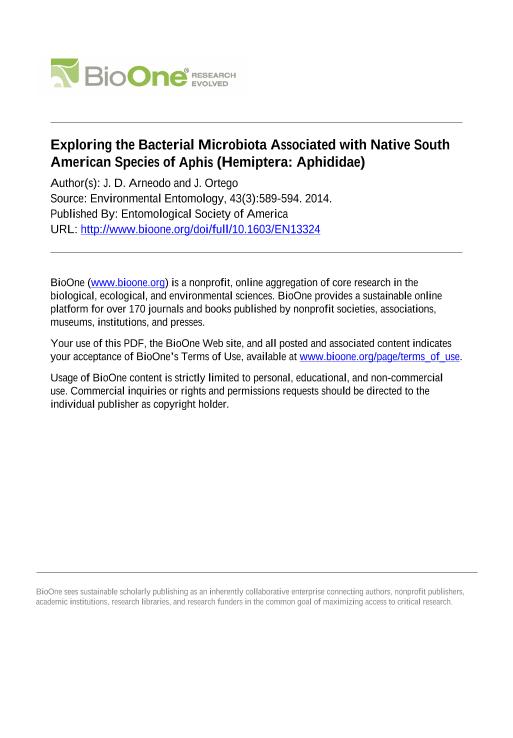Mostrar el registro sencillo del ítem
dc.contributor.author
Arneodo Larochette, Joel Demián

dc.contributor.author
Ortego, Jaime

dc.date.available
2018-01-15T19:48:07Z
dc.date.issued
2014-06
dc.identifier.citation
Arneodo Larochette, Joel Demián; Ortego, Jaime; Exploring the bacterial microbiota associated with native South-American species of Aphis (Hemiptera: Aphididae); Oxford University Press; Environmental Entomology; 43; 3; 6-2014; 589-594
dc.identifier.issn
0046-225X
dc.identifier.uri
http://hdl.handle.net/11336/33328
dc.description.abstract
Aphids harbor a variety of bacterial endosymbionts, including the obligate symbiont Buchnera aphidicola and diverse facultative symbionts. The former supplies its host with essential amino acids. The latter are not indispensable for insect survival, but often improve their host's fitness. To date, the study of such associations was restricted to aphids of Holarctic origin. The bacterial microbiota of seven Aphis species from Argentina was investigated. The presence of B. aphidicola was assessed by specific PCR. Additional symbionts were identified through PCR with eubacterial universal primers, cloning, and sequencing of nearly complete 16S rRNA gene, intergenic spacer region, and partial 23S rRNA gene and subjected to phylogenetic analysis. Infection with B. aphidicola was confirmed in every species analyzed. The facultative symbiont Serratia symbiotica was detected in Aphis malalhuina Mier Durante, Nieto Nafría & Ortego, 2003, Aphis senecionicoides Blanchard, 1944, and Aphis schinifoliae Blanchard, 1939, while Hamiltonella defensa was identified in Aphis mendocina Mier Durante, Ortego & Nieto Nafría, 2006. Arsenophonus sp. was found infecting Aphis melosae Mier Durante & Ortego, 1999, and a new, undescribed Aphis sp. In Aphis danielae Remaudière, 1994, no facultative symbionts could be recorded. When analyzing the highly conserved 16S rRNA gene, the phylogenetic tree grouped the S. symbiotica, H. defensa, and Arsenophonus isolates into three well-defined clusters showing little variability among clones corresponding to the same aphid host species. This article reports for the first time the endosymbionts associated with aphids native to South America. Despite their geographic origin, the qualitative composition of their microbiota revealed no evident differences from that described for aphids in the Northern Hemisphere.
dc.format
application/pdf
dc.language.iso
eng
dc.publisher
Oxford University Press

dc.rights
info:eu-repo/semantics/openAccess
dc.rights.uri
https://creativecommons.org/licenses/by-nc-sa/2.5/ar/
dc.subject
Aphid
dc.subject
Endosymbiont
dc.subject
Molecular Characterization
dc.subject
Serratia Symbiotica
dc.subject
Hamiltonella Defensa
dc.subject.classification
Agricultura

dc.subject.classification
Agricultura, Silvicultura y Pesca

dc.subject.classification
CIENCIAS AGRÍCOLAS

dc.title
Exploring the bacterial microbiota associated with native South-American species of Aphis (Hemiptera: Aphididae)
dc.type
info:eu-repo/semantics/article
dc.type
info:ar-repo/semantics/artículo
dc.type
info:eu-repo/semantics/publishedVersion
dc.date.updated
2018-01-11T13:46:16Z
dc.identifier.eissn
1938-2936
dc.journal.volume
43
dc.journal.number
3
dc.journal.pagination
589-594
dc.journal.pais
Reino Unido

dc.journal.ciudad
Oxford
dc.description.fil
Fil: Arneodo Larochette, Joel Demián. Consejo Nacional de Investigaciones Científicas y Técnicas; Argentina. Instituto Nacional de Tecnología Agropecuaria. Centro de Investigación en Ciencias Veterinarias y Agronómicas. Instituto de Microbiología y Zoología Agrícola; Argentina
dc.description.fil
Fil: Ortego, Jaime. Instituto Nacional de Tecnología Agropecuaria. Centro Regional Mendoza-San Juan. Estación Experimental Agropecuaria Mendoza; Argentina
dc.journal.title
Environmental Entomology

dc.relation.alternativeid
info:eu-repo/semantics/altIdentifier/url/https://academic.oup.com/ee/article-abstract/43/3/589/398736?redirectedFrom=fulltext
dc.relation.alternativeid
info:eu-repo/semantics/altIdentifier/doi/http://dx.doi.org/10.1603/EN13324
Archivos asociados
